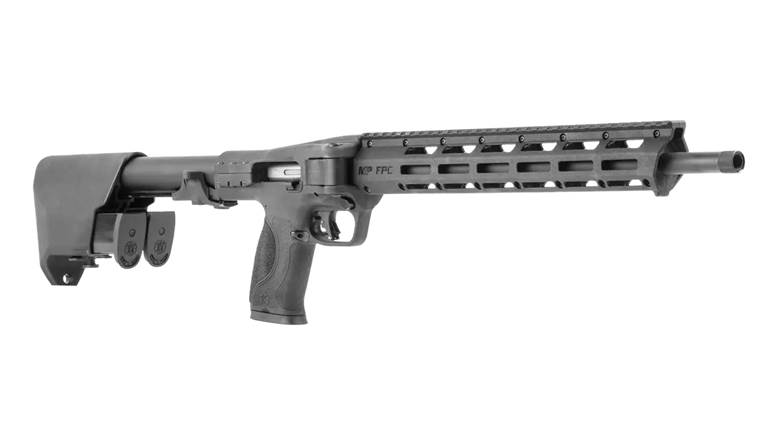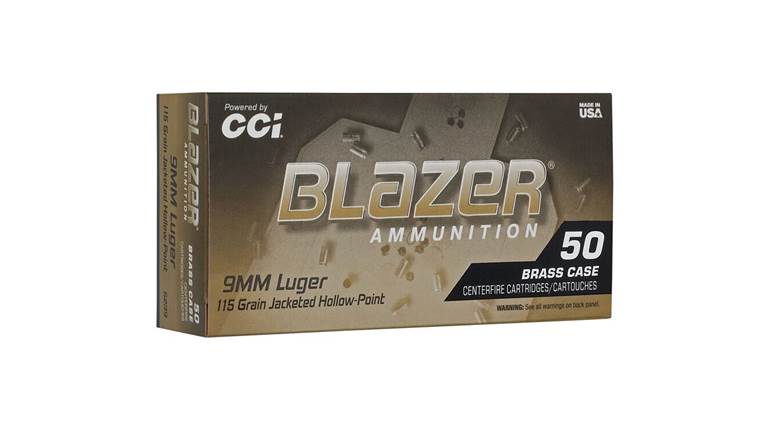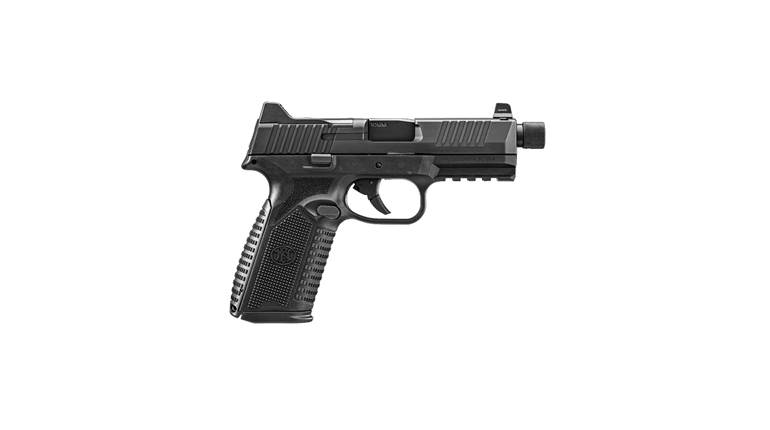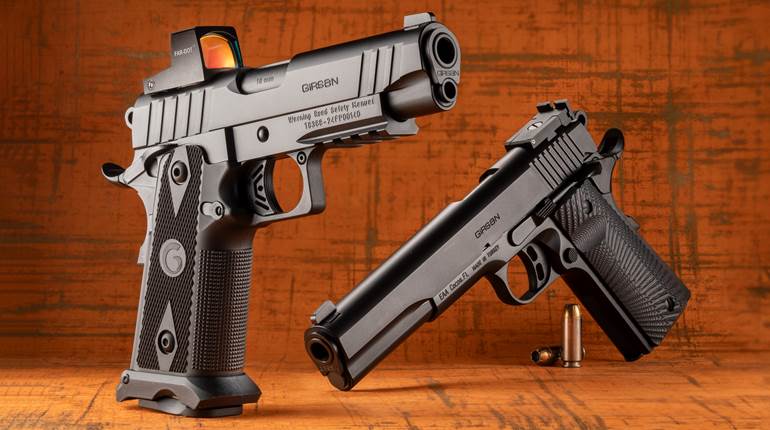
In "Nine Lives of the 10 mm Auto" (American Rifleman, August 2018) Field Editor Jeremiah Knupp surveyed the history of the 10 mm Auto cartridge and took a look at five current firearms that chamber the high-performance cartridge. Space limitations in the print magazine did not permit the inclusion of tables denoting the guns’ specifications and listing their accuracy and velocity figures with various loads. They also precluded an additional sidebar on 10 mm Auto carbines, so all of the aforementioned have be included here.
—The editors.
Grand Power P40L 10 mm
The P40 comes supplied with two front sights, one marked “0” and a second marked “+1.” We found the “+1” front sight to be right on at 10 yds. but about two inches low at 25 yds. The “0” front sight corrected this point of impact for 25 yd. shooting. The front sight is changed by removing the roll pin that holds it to the slide. The rear sight is adjustable in its dovetail by loosening the Allen head screw and moving it right or left.
The P40 is designed to release the slide and chamber a round automatically when a full magazine is inserted.
A full description of the functioning of the P40’s safety/decocker mechanism:
- Racking the slide with the safety/decocker lever in the “neutral”/off position moves the hammer to the fully-cocked position.
- With the hammer in the fully-cocked position the safety/decocking lever can be moved up or “on safe.” It stays in this position and prevents the pistol from being fired (Condition One - “cocked and locked”).
- With the hammer fully cocked, pushing the lever down to the decocked position moves the hammer to the half-cocked position.
- If the safety/decocker lever is returned to the “neutral”/off position after decocking a double-action trigger pull will fully cock the hammer and fire the pistol. The hammer will return to the full-cocked position with every subsequent shot and only require a single-action trigger pull to fire the pistol.
- If the safety/decocker lever is left in the down position the hammer will return to the fully forward position after each shot, requiring a full double-action trigger pull each time. With the lever in the down position the hammer will return to the half-cock position after racking the slide.
Disassembling and re-assembling the P40 takes a bit of practice. We found the following technique to work the best:
- Remove the magazine and make sure the pistol is unloaded.
- Resting the butt of the grip against the chest, grasp the Glock-esque disassembly latch (located above the front of the trigger guard) on both sides of the frame and pull it down, while simultaneously grasping the slide by its serrations and pulling it to the rear.
- Once the slide assembly has moved as far as it can to the rear, lift the rear of the slide up so that it clears the frame rails.
- Move the slide forward and off the recoil spring. Note: The recoil spring assembly stays captured in the frame during field stripping.
Re-assembling the pistol is accomplished by reversing the above instructions:
- Start out with the barrel moved as far forward as possible in the slide with its camming surface facing down (towards the frame).
- Holding the frame and slide in the position used for disassembly, insert the recoil spring into its holder in the front of the slide.
- While holding the disassembly latch down, pull the slide as far as possible to the rear. At its furthest point of travel, push the rear of the slide down onto the frame.
- Let the slide assembly move forward and onto the frame rails.


EAA Witness Hunter
EAA warns against using +P or “High Velocity High Pressure” factory ammunition in their handguns. Consult with them about their ammunition recommendations before using the ammunition we tested in an EAA firearm.
The Witness Hunter is supplied with an airline approved, custom-fitted Negrini case with a built in combination lock and a complete cleaning kit with brushes, jags and rod.
Trigger take-up and over-travel screws are adjusted with the supplied Allen wrench. The same wrench is used to remove the screw that holds the front sight in place. The Hunter’s rear “Super Sight” features a wide Bo-Mar-like leaf with its surface serrated to reduce glare. The rear sight is click adjustable for both windage and elevation with a screwdriver.
The Witness Hunter comes with a 15-lb. recoil spring installed and spare 14- and 11-lb. springs. The company rates the 15-lb. spring to 1250 f.p.s. with 180-gr. bullets and 1050 f.p.s. with 200-gr. bullets. We tested the HSM ProPistol Hunter load (180-gr. bullet at 1150 f.p.s.) with the stock 15-lb. spring. Before switching to the heavier loads we installed a 22-lb. recoil spring from Wolff. After switching to the heavier spring we went back to shooting some light loads (180-gr. bullet at 1150 f.p.s.) and the pistol functioned perfectly with the heavier spring installed.
The heavier recoil spring we installed came from a Wolff Extra Power Recoil Calibration Pak that includes 16, 18, 20 and 22-lb. recoil springs, along with two extra power firing pin springs. Despite its long barrel the Witness Hunter uses a standard length recoil spring (Wolff’s part number for the kit is 13121).
Since the Witness Hunter has the extended controls of EAA’s competition firearms those hunting with gloves may find they inadvertently drop a magazine or interfere with the slide release. Standard-sized magazine releases and slide releases from the Witness line can be installed.
With the EAA factory scope mount (EAA part number 102102) installed and the rear sight in place the Witness Hunter cannot be disassembled. The best solution is to remove the rear sight before installing the scope mount. With the Witness Hunter’s low scope mounting position the open sights cannot be used with the scope mounted. Though we did not experience any shift in zero after removing the scope from our test pistol for cleaning or to switch out recoil springs the mounting screws tended to work loose if no Loctite was applied to them (see below).
EAA recommends applying red or blue Loctite to the scope mount screws. We did not apply the Loctite on the screws on our test pistol so that we could swap recoil springs back and forth and found that the scope mount screws loosened in short order. We checked, and often had to tighten them, after every five rounds of our test.
The scope we used in our test was a Weaver 2.5-8X28 Classic Handgun scope (model number 849429), which we attached to the EAA base with Weaver’s Grand Slam 1” Medium rings (part number 49303).
Since 2005 all Witness pistols have shared the same frame size. This means calibers can be changed by swapping the magazine and slide assembly (converting the 10 mm to .40 S&W requires only changing the barrel, recoil spring and magazine). This makes the Witness a flexible 10 mm platform.

Glock 29 Gen 4
To get a full grip on the Glock 29 we added a Pierce Glock 29 Grip Extension (part number PG-29). The extension replaces the factory magazine floor plate and gives space for an extra finger on the grip. The enlarged magazine release button on Gen 4 Glocks helps those with smaller hands reach the button on large-frame Glocks, like the 29.


KRISS Vector CRB 10 mm
A brief description of the KRISS Super V delayed blowback system: When the Vector fires the bolt moves to the rear, pushing on an inclined plane that drives a carrier/inertia block down into a recess behind the magazine housing to compress the action spring. This mechanism, called the “Recoil Mitigation System” by KRISS, directs the recoil force down, instead of back at the shooter. Both the bolt and inertia block move in tracks inside the receiver.
Despite its unique design the KRISS Vector field strips easily for maintenance. No tools are required to disassemble the firearm.
Putting some type of forward grip on the KRISS Vector rifles is recommended as a high left-support hand grip tends to interfere with the bolt release and from a bench rest produced a bolt release bite on the thumb.
While the Vector’s safety lever is ambidextrous, the charging handle, magazine release and bolt release are left side only.
Though at this time 10 mm KRISS Vector owners are limited to the 15-round factory Glock 20 magazine, the company says that it is working on a MagEx system for their 10 mm platform similar to the one offered for Vectors in .45 ACP. That product is an extension that attaches to a factory Glock 21 13-round magazine and expands the capacity to 25 rounds. No word on what the 10 mm MagEx’s capacity will be or when it will be available.
The Vector design allows for the ability to switch calibers. By removing three push pins a different lower receiver, with barrel, bolt and magazine interface, can be interchanged. The 10 mm Vector is also available in a NFA short-barreled rifle format, as well as a pistol (with and without brace), both with 5.5-in. threaded barrels


Colt Delta Elite
The Delta Elite had the most chamber relief of any of the 10 mm firearms we tested. As such we limited it to lighter loads. It did, however, show some case bulging with the Buffalo Bore Tactical Low Flash/Low Recoil load (21E) we tested in it, which launches a 155-gr. bullet at 1350 f.p.s.


Additional Reading:
Nine Lives of the 10 mm Auto
Full Power/Full Auto: The Thompson Goes Metric and the MP5 Goes American






































